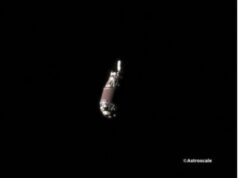Pench Tiger Reserve: A confluence of ‘Eco-tourism & Astro-tourism’
“But without the dark, we’d never see the stars” —Anonymous
Post by COL SATISH SINGH LALOTRA

India that was known in the past in the western world as a ‘land of snake charmers’, swamps, elephants, and such like monikers still leaves no stone unturned to put a stamp of ‘Numerouno’ on itself by executing feats that are still in the realm of dreams in most countries reckoning. It goes to the credit of our democratic governance which seamlessly integrates various organizations and ideas to come up with something new using already existing natural resources that are the ‘Sine quo non’ of a vast landmass falling short of being called as a continent.
One such idea that has been very fruitfully integrated with an already existing resource on ground has been the coming together of ‘Pench Tiger Reserve’ (PTR) with that of ‘international union for conservation of nature (IUCN) under the overall aegis of International astronomical union (IAU) to form the famous ‘Dark sky park’. This confluence of ideas has been the brain child of IUCN which has been advocating relentlessly on the recognition of the intrinsic value of the night sky as a natural, cultural and historical resource. The IUCN also highlights the need to preserve natural darkness for the sake of nature conservation, ecological integrity in protected areas and the well-being of communities in healthy cities.
Welcome to the one of its only kind of conservation effort regarding the tigers that straddles both sides of Maharashtra and Madhya Pradesh—The Pench Tiger reserve (PTR). Due to its USP of being accessible to a large cross section of tourists including the foreign tourists from both Nagpur (Maharashtra) and Seoni (MP) as also featuring in the famous ‘Jungle book’ by Rudyard Kipling this unique tiger reserve caught the attention of IUCN which took this TR(Tiger reserve) to the next level by dovetailing the IAU(Indian astronomical union) and making a common cause of turning the entire environment of PTR as pristine as possible. Both of these organizations highlighted the escalating global threat of light pollution and its attendant risks to this invaluable resource, and thus was born the ‘Dark sky park’ with PTR as its core concept in the Indian sub-continent and the fifth in Asia.
The ‘Dark and quiet skies’ for science and society working group led by the IAU (International astronomical union) has recommended the establishment of ‘Dark sky oases’ by national and local governments. Now what exactly is a ‘Dark sky reserve park’? A dark –sky preserve is an area, usually surrounding a park or observatory that restricts artificial light pollution. The purpose of the dark-sky movement is generally to promote astronomy.Before I move on further on this write up it would be prudent enough for thereaders to understand the essence behind this move of establishment of Dark sky reserve. In simple terms this terminology connotes an area which has minimum or no light pollution. Light pollution refers to the excess amount of artificial light at night which endangers the ecosystem by harming the animals whose lives depend on the dark.
Now here come the nocturnal habits of tigers into focus which remains hamstrung by an extra amount of ambient light that acts as a deterrent for his preying. In fact the more the darkness, the better the prospects of the carnivore inching close to his unsuspecting prey under the shroud afforded by the lack of ambient light . The jungle ‘Kakars’, Monkeys , Langurs etc are too lulled into inaction by the thickness of this darkness who otherwise act as traditional eyes and ears for the jungle denizens to take evasive action on an approaching carnivore or tiger by their incessant barking or howling. This ambient light also creates inconvenience for the astronomers as they are unable to view celestial objects like the stars, planets etc due to excessive amounts of light.
Since a tiger reserve affords a vast area for the observation of celestial objects that are free of artificial lights, a measure has been put into action whereby more than 100 street and community lights in Wagholi, Silari, Pipariya, and Khapa villages of the Paoni UC range buffer area have been replaced with lights facing the ground to mitigate light pollution. As a first in India, the PTR (Pench Tiger Reserve) has inaugurated a night observatory with the district planning committee (DPC) fund with the village of Wagholi earmarked as for stargazing. With this as a beginning, the PTR has catapulted itself into the elite club of those TR (Tiger reserves) in Asia that will act as a magnet not only to attract wild life enthusiasts but also a sizable number of so called ‘Astro-tourists’. An indeed unique combination of tourists for the PTR to take care of.
This concept of DSR (Dark sky reserve) is not a new concept in India. In fact a few months back Dr.Jatinder Singh the MOS(Independent charge) in the PMO had announced at the ‘Ladakh pride festival’ in New Delhi the opening of a DSR at Hanle, Ladakhone of the highest astronomical observatories of Asia and also of the world. Last year I had written an article on the same subject detailing as to how India had woken up latently to its numerous natural resources dotting the countryside and started monetizing their USPs which were lying dormant only to be put into the crucible of country’s tourist map. First Hanle in Ladakh and now a distant PTR have got connected by a common umbilical cord afforded by the august organisations of IUCN & IAU that has got the imagination of various other organisations of our country fired up to make a common cause and pitch India into the world arena of ‘Astro-tourism’ and ‘Eco-tourism’.
Since India forms part of the IAU in the form of ‘Indian national science academy’( INSA) that has member countries of the ilk Australian academy of sciences, the French academy of sciences ,the national academies( USA) ,the national research foundation of South Africa, the national scientific and technical research council etc ; it is no brainer that our country should go hammer and tongs in imbibing the best practices as followed by such lead countries of the world and pitch forward our astronomical knowledge which has been bequeathed to our countless generations from times immemorial.
My interest in penning down this article arose from my aborted attempt to visit this PTR way back in 2011/12 while I was in service and posted at CPE Itarsi. Much though as I wanted to visit Pench tiger reserve, I could only make it to STR (Satpura Tiger Reserve) which is located near Madhai, Hoshangabad in Madhya Pradesh. Paucity of time once again put paid to my plans to veer off to Seoni and visit this excellent tiger reserve perched on the borders of Maharashtra and MP. The need of the hour is to unlock our clogged mindsets/ working in water-tight compartments and instead go for a commonality of purpose as has been shown by the combined might of IUCN & IAU. As has been rightly said—‘But without the dark, we would never see the stars’.



